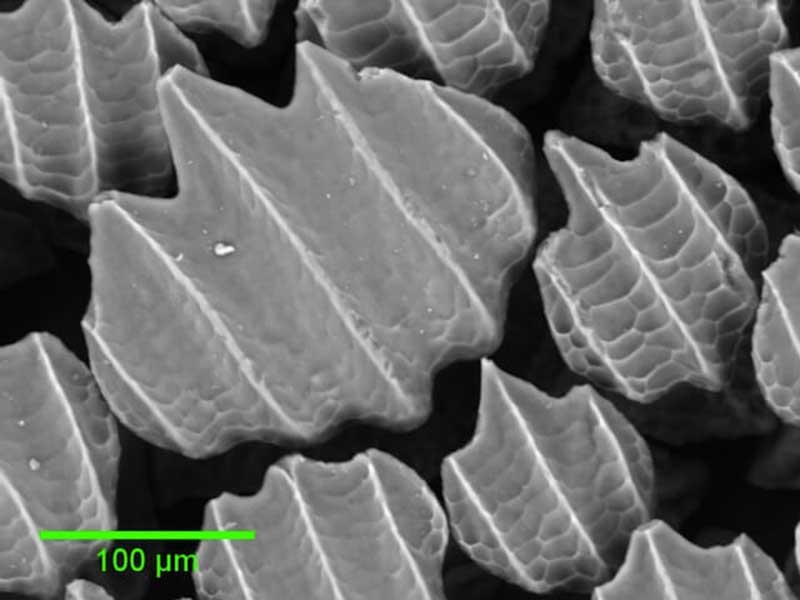- Spider silk super material replicated by genetically engineered micro-organisms
- Faster swimsuits and airplanes – technology inspired by shark skin
- Namibian Beetle shows us how moisture collection is done
- Now you can charge your batteries with… bacteria
- Gecko toes inspired pads enable you to walk up a glass wall
- Hyper-water repellent material inspired by butterfly wings
Nature and technology have traditionally been regarded as opposing forces. There is, however, an intrinsic relationship between ecology and technology; we are part of nature. Yet with our technological developments and having used everything in nature as a resource over the last 2.5 centuries, we have managed to exacerbate our conflicts with this ecosystem. Thankfully, with new approaches to the development of products and technology such as generative design and Biomimicry, we are slowly reversing this trend. More and more, we are looking at technological possibilities that encourage strategic alignment with the ecosystem. One of these technologies is Biomimicry – the process aimed at adopting strategies and patterns found in nature for the creation of sustainable solutions to the challenges we face as a human race. Numerous technological innovations have resulted from mimicking patterns found in nature.
1.Spider silk super material replicated by genetically engineered micro-organisms
The silk spiders use to weave their webs is nothing short of a natural super material. Some of these silks are stronger than steel and they have property combinations that no other synthetic fibre contains. If replicable, humans could use it for manufacturing biodegradable bottles, bulletproof vests and even suspension ropes for bridges. Scientists have spent many years trying to replicate spider silk but it has never been commercially viable as the threads are so delicate that completely new spinning methods would have to be developed in order to weave the threads into fabric. Also, artificial silk could only be used to create durable, tough, lightweight and petroleum-free materials if it were to be manufactured in large quantities. This challenge has now been overcome by Bolt Threads, a startup based in California. The team at Bolt Threads have started using genetically modified yeast brew silk proteins that can alter their properties to create various types of fibres, just like in nature; spiders also ‘fine-tune’ their silk, depending on whether it’s needed to create sticky spots or tough threads to hang from. Bolt Threads’ first range of products made from this material will mainly consist of consumer apparel. The material of the garments would be stronger than nylon and finer than cotton – making them light, soft and durable. The team at Bolt Threads said that their clothes are only the beginning. If they manage to start producing on larger scale, the applications will be endless.
2. Faster swimsuits and airplanes – technology inspired by shark skin
Aside from their razor sharp teeth, sharks are also known for their incredible skin which is covered with denticles – tooth-like scales that give the skin that sandpapery feel. It’s been known for quite some time that these scales enable sharks to reach incredible speeds and manoeuvrability. This is because the denticles disrupt the flow of water that glides over the shark which significantly reduces drag. Scientists have recently developed very realistic artificial shark skin which could improve swimming performance – particularly for swimming robots. They used a micro scanner to scan the skin of a shortfin mako shark at a 1.5 micron resolution. From this scan, they built a 3-dimensional model of a denticle which was digitally replicated thousands of times. The result was then used to develop a computerised simulation of the skin. The next step was to 3D print this artificial shark skin and attach it to both sides of a flexible sheet to mimic the flapping of a fin. During testing, the scientist discovered that swimming speeds using the artificial skin could increase by almost 7 percent and energy required could be reduced by nearly 6 percent. Artificial shark skin in swimwear is extremely effective but complicated to manufacture on a commercial scale. Olympics athlete Michael Phelps and others wore this type of material which enabled them to beat a number of world records – leading to the prohibition of these suits in competitions. The artificial shark skin is however being investigated for use on flexible, fish-like underwater robots. This would reduce the cost of propelling these robots by up to 5 percent which in the long run would be quite significant. Similar structures could be used to reduce drag, manipulate the flow of air or even generate lift. Imagine the applications for aviation, wind turbines, fans and rudders.

3. Namibian Beetle shows us how moisture collection is done
The Namib dessert on the southwest coast of Africa is home to the Namibian Beetle. The Namib is one of the driest deserts in the world but this beetle obtains his water requirements from fog. Each morning it aims its hardened forewings, covered with tiny bumps, at the oncoming fog from the ocean – generating water droplets on its back which slide down to the insect’s mouth. Inspired by this incredible phenomenon, NBD Nanotechnologies, in collaboration with the Massachusetts Institute of Technology, have been developing special coatings based on the same principle – a process which has been relatively successful.
Borrowing this same ‘technology’ from the beetle, designer Pak Kitae developed the ingenious biomimicking Dew Bank bottle that could provide hydration to millions of people that lack accessible drinking water. The Dew Bank bottle’s cap-like innovation mimics the shape, angle and surface of the Namib Beetle’s wings and back, thereby replicating the process with which the beetle collects water. Left outside overnight, the Dew Bank bottle traps hot air which turns to condensation on its cold steel dome surface, collecting it for a glass of clean drinking water the morning after, even in the driest of climates.
4. Now you can charge your batteries with… bacteria
As countries all over the world are working towards decreasing our dependence on fossil fuels and lowering our carbon footprint, renewable energy sources such as solar and wind are steadily gaining ground. Since wind and sunlight don’t generate energy continuously because they in themselves are not constant, we need to find additional ways to store energy as well. The safety issues and high costs of lithium-ion based batteries for storing energy makes compromises suitability. A more sustainable solution for storing energy was developed by a research team at the Wageningen University in the Netherlands. The team combined two separate microbial energy systems – one makes use of bacteria to turn electricity into acetate, while the other converts this acetate back into electricity. They were able to charge and discharge the bacteria-based battery fifteen times in a row. With further development and optimisation, the microbial battery could easily compete with current lithium-ion batteries and in the future, it could safely store renewable energy at much lower cost.
5.Gecko toes inspired pads enable you to walk up a glass wall
Because Gecko toes are covered in setae – thin, long structures in the shape of spatulas – they are able to increase surface area as well as amplify electrical attractions between a surface and the gecko’s toes. Gecko feet have incredible adhesive properties but their feet can also easily be released with the reptile shifting weight. The best part is that these tiny feet never lose their stickiness – which is more than we can say about our adhesive tape. Based on the gecko toes concept, a team of researchers at Stanford University developed a set of hand-size sticky pads. Using these pads, a grad student was able to walk up a glass wall. This type of technology has unlimited potential applications in numerous industries, decreasing the need for chemical adhesives or suction power. The research team is also collaborating with the Jet Propulsion Lab of NASA in a bid to modify the adhesive in such a way that it could be used by robots. Of course, the test with the grad student was done using a very clean, flat and smooth surface. Scientists will therefore still need to demonstrate how the technology holds up in dusty or humid areas.
6. Hyper-water repellent material inspired by butterfly wings
A team of MIT engineers may have created what is described as the most effective water-repellent material ever developed, without modifying any existing hydrophobic surfaces. Their design was inspired by the minuscule ridges found on the wings of the Morpho butterfly as well as on the veins of nasturtium leaves. These asymmetrical ridges cause water droplets to split up in tiny particles after which they are flung outward and off the surface. The material developed with these butterfly wings as inspiration is so effective that even with extremely cold temperatures, water drops immediately bounce off the surface before they have a chance to freeze. The silicon texture can be applied to many different materials and aside from the obvious applications such as water-resistant clothing, it is also very promising for applications in aviation such as for the prevention of frost forming on wings and turbines.
Conclusion
Increasing numbers of new technological innovations draw inspiration from nature. We look to ecological processes and the designs of organisms in nature to show us possibilities never before considered. Biomimicry and generative design are gaining popularity – increasingly mirroring the cycle of evolution. Because so many of our technological innovations are based on what we see in nature, we need to realise the importance of conserving the environment. Ecological research and initiatives to preserve our animal and plant species should therefore high on our list of priorities – the survival of humanity depends on it.
Share via:



